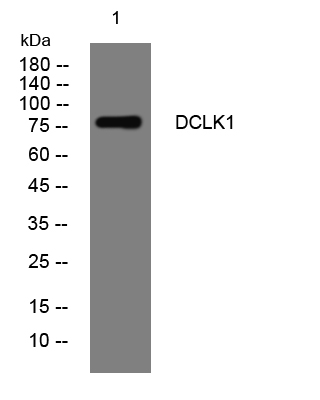DCLK1 rabbit pAb
- Catalog No.:YT6620
- Applications:WB
- Reactivity:Human;Mouse;Rat
- Target:
- DCLK1
- Gene Name:
- DCLK1 DCAMKL1 DCDC3A KIAA0369
- Protein Name:
- DCLK1
- Human Gene Id:
- 9201
- Human Swiss Prot No:
- O15075
- Mouse Gene Id:
- 13175
- Mouse Swiss Prot No:
- Q9JLM8
- Rat Gene Id:
- 83825
- Rat Swiss Prot No:
- O08875
- Immunogen:
- Synthesized peptide derived from human DCLK1 AA range: 514-564
- Specificity:
- This antibody detects endogenous levels of DCLK1 at Human/Mouse/Rat
- Formulation:
- Liquid in PBS containing 50% glycerol, 0.5% BSA and 0.02% sodium azide.
- Source:
- Polyclonal, Rabbit,IgG
- Dilution:
- WB 1:500-2000
- Purification:
- The antibody was affinity-purified from rabbit antiserum by affinity-chromatography using epitope-specific immunogen.
- Concentration:
- 1 mg/ml
- Storage Stability:
- -15°C to -25°C/1 year(Do not lower than -25°C)
- Molecular Weight(Da):
- 81kD
- Background:
- This gene encodes a member of the protein kinase superfamily and the doublecortin family. The protein encoded by this gene contains two N-terminal doublecortin domains, which bind microtubules and regulate microtubule polymerization, a C-terminal serine/threonine protein kinase domain, which shows substantial homology to Ca2+/calmodulin-dependent protein kinase, and a serine/proline-rich domain in between the doublecortin and the protein kinase domains, which mediates multiple protein-protein interactions. The microtubule-polymerizing activity of the encoded protein is independent of its protein kinase activity. The encoded protein is involved in several different cellular processes, including neuronal migration, retrograde transport, neuronal apoptosis and neurogenesis. This gene is up-regulated by brain-derived neurotrophic factor and associated with memory and general cognitive abilities. Multiple transcript variants generated by two alternative promoter usage and alternative splicing have been reported, but the full-length nature and biological validity of some variants have not been defined. These variants encode different isoforms, which are differentially expressed and have different kinase activities.[provided by RefSeq, Sep 2010],
- Function:
- alternative products:Additional isoforms seem to exist. Type A (AS and AL) and type B (BS and BL) isoforms differ respectively by the presence or absence of the doublecortin domain. An alternative splicing occurring in 3' of the mRNA produces the long (L) instead of the short (S) isoforms,catalytic activity:ATP + a protein = ADP + a phosphoprotein.,function:Probable kinase that may be involved in a calcium-signaling pathway controlling neuronal migration in the developing brain. May also participate in functions of the mature nervous system.,similarity:Belongs to the protein kinase superfamily. CAMK Ser/Thr protein kinase family. CaMK subfamily.,similarity:Contains 1 protein kinase domain.,similarity:Contains 2 doublecortin domains.,tissue specificity:In fetal tissues, highly expressed in brain, detectable in lung and liver, but not in kidney. In adult tissues, expressed ubiquitously in
- Subcellular Location:
- intracellular,integral component of plasma membrane,postsynaptic density,
- Expression:
- In fetal tissues, highly expressed in brain, detectable in lung and liver, but not in kidney. In adult tissues, expressed ubiquitously in the brain, detectable in the heart, liver, spleen, thymus, prostate, testis, ovary, small intestine and colon. The type A isoforms seem to be expressed predominantly in fetal brain whereas type B isoforms are expressed abundantly in both fetal and adult brain.
- June 19-2018
- WESTERN IMMUNOBLOTTING PROTOCOL
- June 19-2018
- IMMUNOHISTOCHEMISTRY-PARAFFIN PROTOCOL
- June 19-2018
- IMMUNOFLUORESCENCE PROTOCOL
- September 08-2020
- FLOW-CYTOMEYRT-PROTOCOL
- May 20-2022
- Cell-Based ELISA│解您多样本WB检测之困扰
- July 13-2018
- CELL-BASED-ELISA-PROTOCOL-FOR-ACETYL-PROTEIN
- July 13-2018
- CELL-BASED-ELISA-PROTOCOL-FOR-PHOSPHO-PROTEIN
- July 13-2018
- Antibody-FAQs
- Products Images

- Western blot analysis of lysates from A549 cells, primary antibody was diluted at 1:1000, 4°over night



